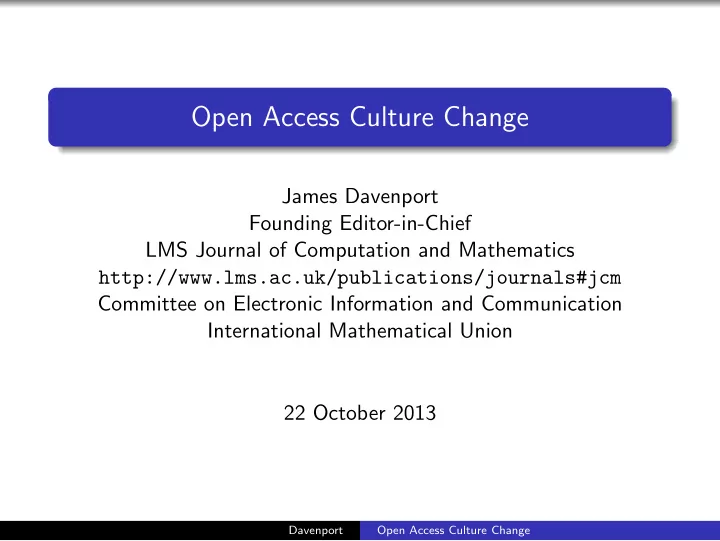

Open Access Culture Change James Davenport Founding Editor-in-Chief LMS Journal of Computation and Mathematics http://www.lms.ac.uk/publications/journals#jcm Committee on Electronic Information and Communication International Mathematical Union 22 October 2013 Davenport Open Access Culture Change
http://arxiv.org/ Origin Ginsparg, 1991 See http://people.ccmr.cornell.edu/~ginsparg/ blurb/pg96unesco.html 1999 “Paper journals are a testament to the dinosaur mentality of tenure committtees” 2001 The concept of “open access” (as it became called) was endorsed by the International Mathematical Union: http://www.mathunion.org/fileadmin/ CEIC/Publications/Call_to_All_ Mathematicians_to_Make_Publications_ Electronically_Available.pdf Davenport Open Access Culture Change
Mathematics Today No reputable mathematics journal does not support green OA (at least) While estimates vary, consensus is that over 50% of current “published” mathematics research is Open Access ⑧ The problem lies in formulating the question — what is “published”, what is “mathematics” and what is “research”. Davenport Open Access Culture Change
Mathematics Statements [AET08] states “Relying on statistics is not more accurate when the statistics are improperly used”. It also makes the fundamental point “Research usually has multiple goals and it is therefore reasonable that its value must be judged by multiple criteria” Proc. AMS has 0.434 citations/article and Trans. AMS has 0.846 (within the impact factor range) So a Trans AMS article is better? The probability that a random Proc. article has at least as many citations as a random Trans. article is 62%: i.e. the obvious deduction is wrong. Davenport Open Access Culture Change
Adler et al. page 7 June 2008 Citation Statistics IMU ‐ ICIAM ‐ IMS Citation Curves 14% Impact Percent of 2003 citations 12% Factor 10% Cell Biology 8% Education 6% Economics 4% Mathematics 2% 0% 2003 2002 2001 2000 1999 1998 1997 1996 1995 1994 A graph showing the age of citations from articles published in 2003 covering four different fields. Citations to article published in 2001 ‐ 2002 are those contributing to the impact factor; all other citations are irrelevant to the impact factor. Data from Thomson Scientific. Does the two ‐ year interval mean the impact factor is misleading? For mathematics journals the evidence Davenport Open Access Culture Change is equivocal. Thomson Scientific computes 5 ‐ year impact factors, which it points out correlate well with ‐ ‐ ‐ ‐ ‐ ‐ ‐
Wider Science Impact Factor is like Libor: once it’s worth money, people will manipulate it. It is often thought that these are trivial, and we laugh at “to be accepted in this journal, your paper must reference at least two other papers in the [name deleted]”, but it can be serious. El Naschie ’s self-citations made Chaos, Solitons and Fractals into Number 2 in ISI’s “Mathematics, Interdisciplinary Applications” category. International Journal of Nonlinear Science and Numerical Simulation gamed itself, via Journal of Physics: Conference Series , into the “highest impact” journal in Applied Mathematics. No member of my committee had ever heard of this journal until our attention was drawn to it. [Arn09] International Council of Science Unions is debating this issue at the moment. Davenport Open Access Culture Change
French Statement (2011) Note that this is important because of the hghly centralised of the French academic system. “ L’´ evaluation doit porter sur les articles et non sur les revues ”: Clause 1 of recommendation 1. [Aca11] My translation: Evaluation should be based on the articles and not on the journals Davenport Open Access Culture Change
Personal Observations The cost of running any sort of journal has plummeted. This is often confused with the OA movement The fact that two things happend at the same time does not mean that they are the same thing! Physical page limits have acted as an economic filter in the past, but this has essentially disappeared The fact that three things happend at the same time does not mean that they are the same thing! Academics are not getting less busy, and peer review is under pressure everywhere There is a lot going on, and the publishing model is probably in greater flux at any time than Gutenberg/Caxton Davenport Open Access Culture Change
Bibliography Acad´ emie Des Sciences Institut de France (ed. J.-F. Bach). Du bon usage de la bibliom´ etrie pour l’´ evaluation individuelle des chercheurs: Rapport remis le 17 janvier 2011 ` a Madame la Ministre de l’Enseignement Sup´ erieur et de la Recherche. http://hal.archives-ouvertes.fr/hal-00604117 , 2011. R. Adler, J. Ewing, and P. Taylor. Citation Statistics: An International Mathematical Union report. http://www.mathunion.org/fileadmin/IMU/Report/ CitationStatistics.pdf , 2008. D.N. Arnold. Integrity Under Attack: The State of Scholarly Publishing. SIAM Review 12 , 42, 2009. Davenport Open Access Culture Change
Recommend
More recommend